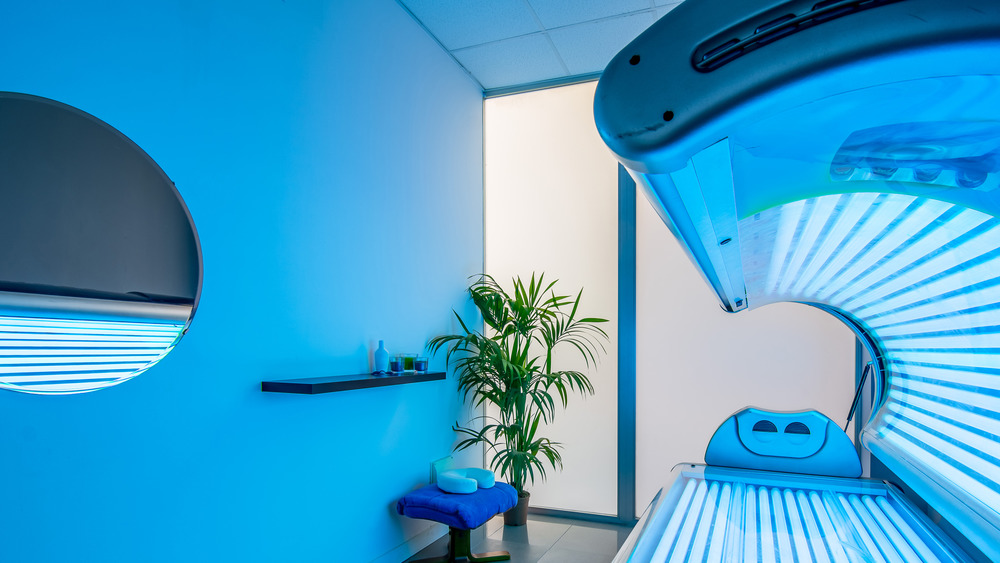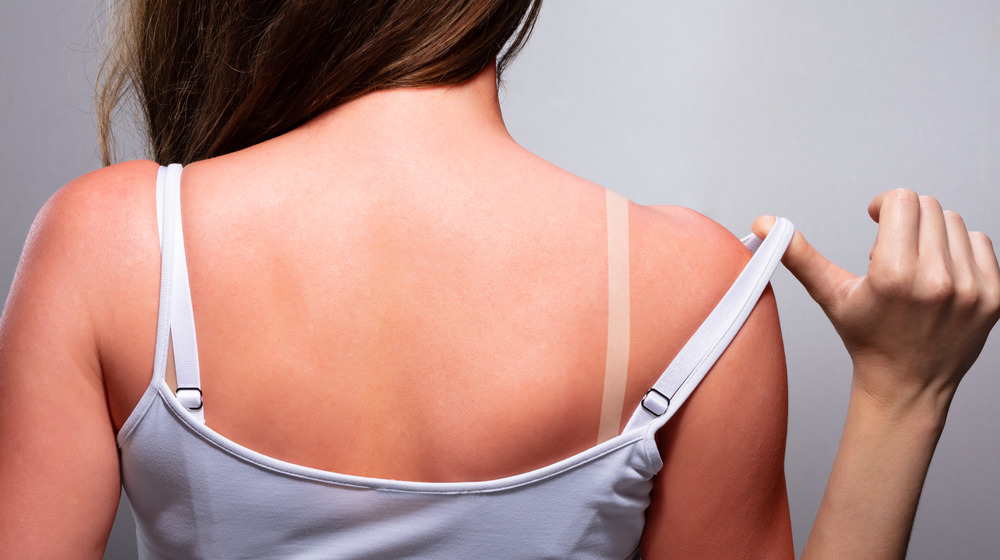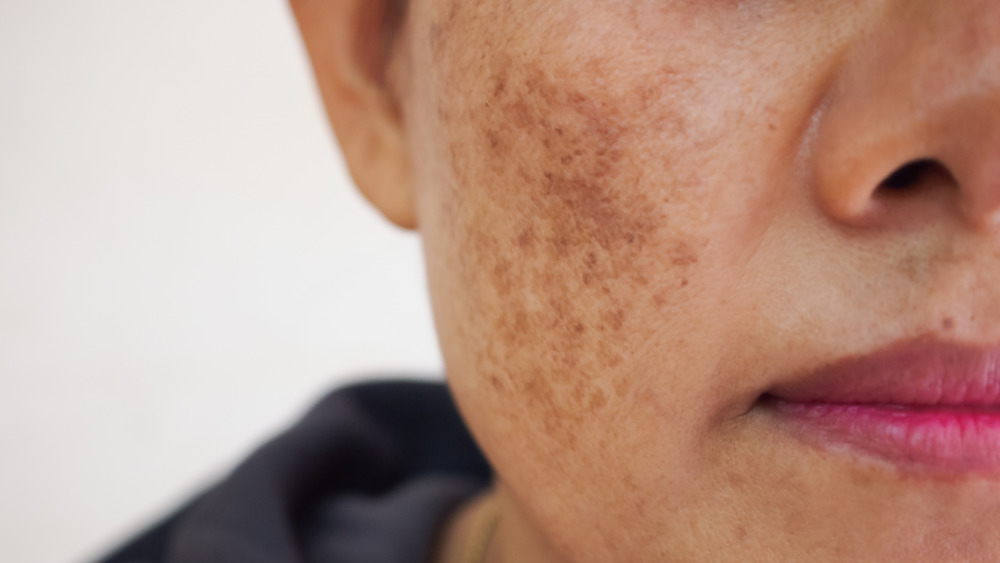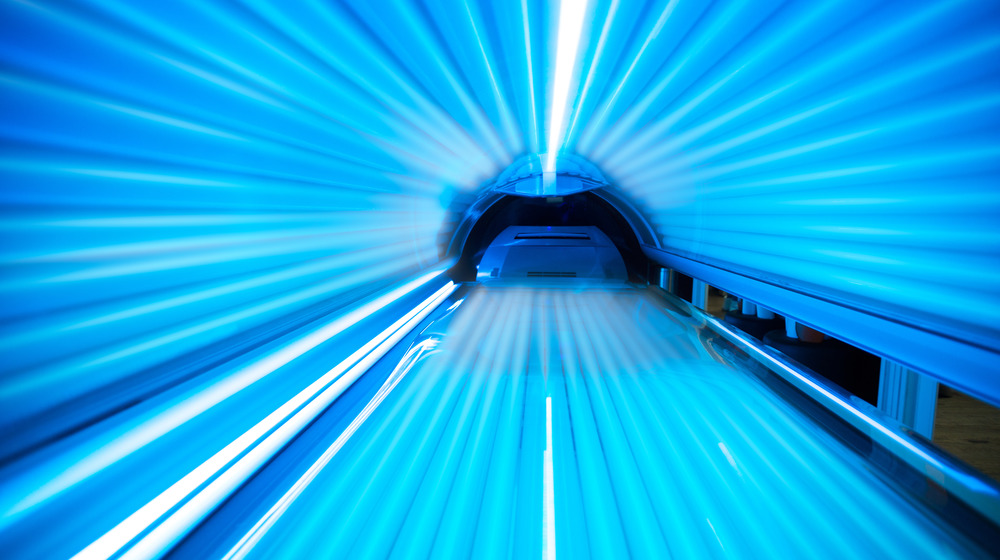The Real Risk You're Taking When You Use A Tanning Bed
You might be surprised to learn what getting a tan really does to your skin. Maybe you know that the sun's rays are harmful to your skin, even if you don't get a sunburn, but what about tanning beds? There are quite a few risks of using a tanning bed, and tanning in a bed rather than outside in the sun is not safer, according to the American Academy of Dermatology Association (AAD). There is no safe tanning bed, tanning lamp, or tanning booth, and along those same lines, there is also really no safe tan.
One indoor tanning session can increase your risk of melanoma by 20 percent, basal cell carcinoma by 29 percent, and squamous cell carcinoma by 67 percent. Melanoma is the deadliest form of skin cancer.
According to a 2016 study, younger women who used indoor tanning had a 2.3- to 6-fold increase in melanoma. See a dermatologist if you have a new mole or mole that has changed, as it could be a melanoma.
The American Cancer Society estimated that in 2020, over 100,000 new melanomas were diagnosed, and nearly 7,000 people will die from melanoma. According to the Melanoma Research Alliance, melanoma is preventable by avoiding indoor tanning and taking precautions when out in the sun.
Health effects of tanning and sunburns
Tans and sunburns both increase your risk for skin cancers. The only way to remove skin cancer, if it's caught early, is to have a dermatologist shave, freeze, or cut it out of your skin and send it off for a biopsy. If the lab finds cancer in the cells, they may need to remove more for another biopsy. If they find cancer, they might have to remove part of your lymph nodes to see if the cancer has spread (via the National Cancer Institute).
Getting a tan, or base tan, will not prevent you from getting a sunburn and isn't safe. A sunburn is skin damage that causes your skin to turn red and feel warm. Your immune system removes the damaged cells, causing a sunburn, according to the FDA. It's not just painful — getting five sunburns doubles your risk of melanoma (via the Skin Cancer Foundation).
How tanning causes premature aging
Tanning causes premature aging, a speeding up of the skin's natural aging process. Symptoms are wrinkles, dark spots or age spots, loose skin, and a leathery texture. When your skin is exposed to the sun's harmful UV rays or tanning beds, it breaks down the collagen in your skin. Collagen keeps your skin healthy and young-looking by keeping it firm.
Premature aging from UV rays is entirely preventable, thankfully. Avoid tanning beds, lamps, and booths. Protect yourself from the sun when exposed to it by using sunblock, hats, and avoiding the peak hours of sunlight — between 10 in the morning and 4 in the afternoon, according to the U.S. Environmental Protection Agency. The more you tan and the more sunburns you get, the worse the premature aging will be. You can see a dermatologist for premature aging treatments, which include dermabrasion, chemical peels, and fillers.
How tanning causes keratosis and eye damage
Actinic or solar keratosis is a premalignant growth that can turn into skin cancer. It's caused by long-term exposure to sunlight, and more than 5 million Americans get solar keratosis every year. The scaly, rough, raised bumps show up in areas of the skin that have been tanned or sunburned. Treatment is a chemical peel or liquid nitrogen by a dermatologist. It's incredibly common, so see a dermatologist if you notice anything like this.
Another risk of tanning beds is eye damage called photokeratitis, also known as snow blindness because many people get it in snowy environments at high altitudes. It's a sort of sunburn in the eye. Other causes of photokeratitis are certain tanning lamps and broken mercury vapor lamps. Symptoms are tearing, hazy vision, decreased vision, feeling like there's sand in the eye, swollen eyelids, and pain. If you experience this, see your doctor for a topical solution that will help your eyes heal.
UV exposure can also cause cataracts, eye damage that leads to decreased vision, and blindness. Symptoms are pain in and around the eyes and cloudy or spotty vision. Treatment is cataract surgery.
How tanning can suppress the immune system
Tanning can also affect your immune system, according to the FDA. Overexposure to UV radiation, such as using tanning beds regularly, can damage your immune system. The symptoms are decreased effects of vaccines, increased sensitivity to the sun, and reactions to some medications. It can also affect how your skin naturally protects itself.
Exposure to these harmful rays, whether outside or in a tanning bed, can also affect how your body reacts to the treatment of the herpes simplex virus. It can reactivate the infection, causing sores to reappear because the immune system isn't working properly and can't keep the virus under control.
Keep your immune system and skin healthy by avoiding tanning beds, tanning lamps, tanning booths, and protecting yourself from the sun while outside. You can take precautions to prevent skin cancer, eye damage, and premature aging.





